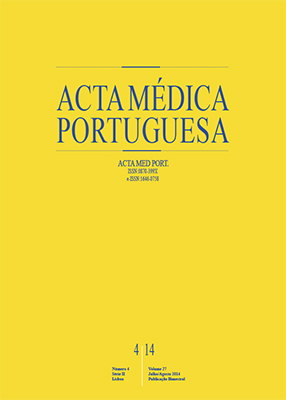Omental Infarction: a Reappraisal of Conservative Management in Children
DOI:
https://doi.org/10.20344/amp.4996Abstract
Introduction: Accurate recognition of omental infarction has resulted in increasing supporters of non-operative approach. In order to assess the efficacy and safety of conservative management, we surveyed the cases of omental infarction treated at a single institution.
Material and Methods: Primary omental infarction treated between 2004 and 2011 were reviewed. Cases recognized by imaging studies were submitted to conservative treatment that consisted of intravenous analgesics and antibiotics. Demographics, clinical presentation, laboratory findings, imaging diagnosis and outcome were analyzed.
Results: There were 9 cases of omental infarction. Eight patients (4 males; median age, 8.5 years) presented at initial course of disease; all had right-sided abdominal pain and a normal or lightly increased leukocyte count. Six cases, diagnosed by CT scan after US suspicion in four, were managed conservatively, recovered uneventfully, and were discharged after a median hospital stay of 3 days. Two patients were only recognized at surgery. An additional case presented with intestinal obstruction due to an internal hernia and was successfully resolved by laparoscopy.
Discussion: Imaging techniques were diagnostic of omental infarction in the majority of cases, enabling a conservative approach to be adopted. Non-operative management was successful with no complications in all patients presenting at the initial course of disease. One patient presented with a harmful complication that required operative treatment.
Conclusion: In the absence of a standard approach for omental infarction, conservative management is an effective noninvasive alternative but it claims for active surveillance.
Keywords: Infarction; Omentum.
Downloads
Downloads
Published
How to Cite
Issue
Section
License
All the articles published in the AMP are open access and comply with the requirements of funding agencies or academic institutions. The AMP is governed by the terms of the Creative Commons ‘Attribution – Non-Commercial Use - (CC-BY-NC)’ license, regarding the use by third parties.
It is the author’s responsibility to obtain approval for the reproduction of figures, tables, etc. from other publications.
Upon acceptance of an article for publication, the authors will be asked to complete the ICMJE “Copyright Liability and Copyright Sharing Statement “(http://www.actamedicaportuguesa.com/info/AMP-NormasPublicacao.pdf) and the “Declaration of Potential Conflicts of Interest” (http:// www.icmje.org/conflicts-of-interest). An e-mail will be sent to the corresponding author to acknowledge receipt of the manuscript.
After publication, the authors are authorised to make their articles available in repositories of their institutions of origin, as long as they always mention where they were published and according to the Creative Commons license.









